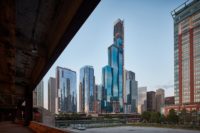Related, SOM Unveil 400 Lake Shore Drive, a Plan for the Former Chicago Spire Site
Latest plan for the site with a decade-old construction hole would add two more residential towers to Chicago's lakefront

Related Midwest recently unveiled its proposal for 400 Lake Shore Drive, two towers set 150-ft apart designed by architect David Childs with fellow architect Scott Duncan and structural engineer William Baker of Skidmore Owings & Merrill (SOM).
The plan for the 2.2-acre, waterfront site that's been home to a 76-ft-deep construction hole for a decade calls for a 1,100-foot southern tower containing 300 condo units and 175 hotel rooms and an adjoining 850-foot tower with 550 rental apartments. The hole was left behind when the 2,000-foot-tall Chicago Spire project, designed by Santiago Calatrava, halted construction right in the middle of the global financial crisis in 2008. Several developers tried to revive the Spire project to no avail. Childs said SOM chose a terracotta and glass facade to reference Chicago's architectural history but also to dampen the noise from busy Lake Shore Drive.
"Located where the City of Chicago was founded – at the meeting of Lake Michigan and the Chicago River – we are proposing a new urban destination: two residential towers, iconic both at their base and in the sky, differing in placement, rotation, and height," Childs says.
Located on one of the few open waterfront sites in Chicago, the two-tower development still requires city approval but Related Midwest hopes to break ground on both towers in the summer of 2019 and deliver the project by 2023 The site is the last undeveloped ground at the mouth of the Chicago River and Related said it plans a mix of luxury apartment and condominium residences as well as a boutique hotel, with an adjacent Riverwalk that will provide pedestrian access to the lakefront from downtown. The combined 1,025 residential and hotel units of the plan represent a step down from the 1,200 condos of the previously-approved plan which would require a zoning variance. Related also pledged $10 million to build pathways to a new DuSable a park long planned but never built on a 3.3-acre peninsula north of the Chicago River and east of Lake Shore Drive to honor African-American pioneer Jean Baptiste Point du Sable. Related did not release financial cost projections beyond its pledge to the park development, but the two-tower development would likely cost at least $1 billion to finance in Chicago's construction market.
The 1,100-ft-tall tower represents the latest of several supertall buildings including One Chicago Square and the redevelopment of the Tribune Tower property in the planning or construction stages that could significantly change Chicago's skyline. Only the Willis Tower, Trump Tower, the Aon Center, and 875 N Michigan Ave. (formerly known as the John Hancock Tower) would be taller than it if built as planned.





